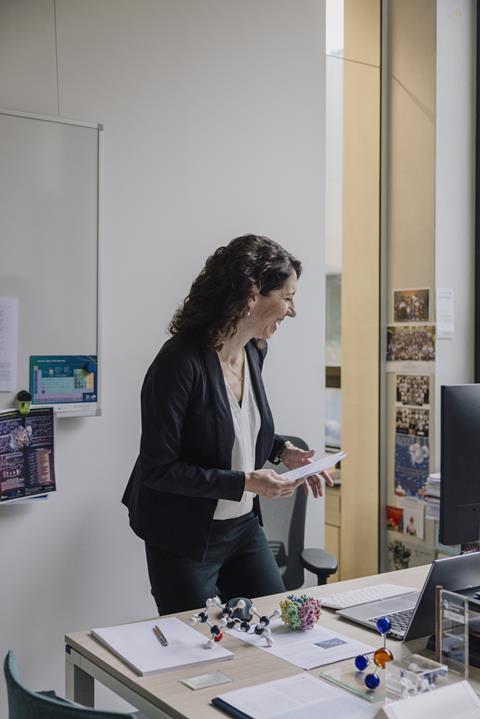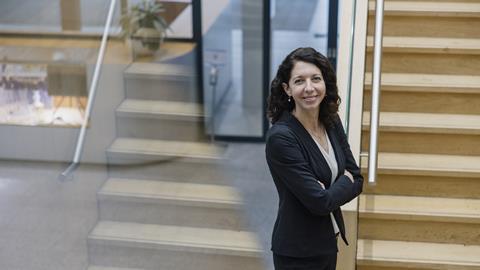She has been praised for her innovative research on enzymes and cofactors, which can make chemical synthesis more selective and greener. According to KNCV Gold Medal winner Caroline Paul, biocatalysis offers many opportunities, but it is not by default more sustainable than chemical synthesis. ‘You do have to look at the numbers and make a fair comparison.’
Caroline Paul knew she had been nominated for the KNCV Gold Medal, but when an unknown number appeared on her phone in early October, she had long since forgotten about it. ‘In April, a colleague had asked for my resume, but I didn’t hear anything after that. I assumed I wasn’t selected. And you know: there are so many colleagues who also deserve the award. So when KNCV President Yvonne van der Meer called, it was a very nice surprise.’
The KNCV Gold Medal jury praised Caroline Paul’s original biocatalysis research, which provides both fundamental insights and new industrial applications. She has made a name for herself in recent years especially with innovative studies on cofactors: molecules that enzymes require to do their catalytic work. But developing new synthetic strategies for existing industrial processes is also an important line of research.
‘I don’t think we necessarily need to replace all existing chemical processes with enzymatic processes’
Caroline Paul is the daughter of Parisian parents: she was born in Toronto and grew up in Canada and France. In high school, she was not so much interested in chemistry as in biology. ‘I was curious and fascinated by the chemistry of life: biology, physiology and medicine. As a teenager, I gave a tutorial at school about chemotherapy. My uncle died of cancer and I saw him turn into an old man because of the treatment. I wanted to know how such a treatment works, because it involves a toxic substance that targets rapidly dividing cells. I wanted to understand what cancer is and how the immune system works. No one at home could really explain that to me very well, so I went looking for answers myself.’
Medicine is also an interesting interface between chemistry and biology.
‘I spoke with university professors at the university to find out if I should study medicine. In France, you apply to medical school right after high school, whereas in Canada, you study three years of undergraduate first. I’m grateful I had those three years, because in my first year at the University of Toronto, I had truly inspiring chemistry teachers and ended up choosing a specialization in biological chemistry. My MSc thesis revolved around the synthesis of sugars without protecting groups - that’s very challenging. It triggered me to work with enzymes because they are very selective. Then I looked for a PhD topic with a combination of biocatalysis and organic chemistry. That’s how I ended up in Spain, in Oviedo, with a group that uses enzymes as catalysts to synthesize chemicals. After my PhD, I moved to Delft for a postdoctoral project and have been in the Netherlands ever since.’
In biocatalysis you can go in many directions. What appeals to you the most?
‘The interdisciplinary: organic synthesis, enzymology, molecular biology and the use of microorganisms. I’m still a chemist at heart, but you can go in many directions with different disciplines. And I also like the link to the direct application. The molecules we synthesize are used in the pharmaceutical industry, fine chemicals and the production of fragrances.’
The jury report for the Gold Medal praises your work on synthetic cofactors. Why would you want to replace natural cofactors?
‘Many enzymes need a cofactor to catalyze reactions, including those used in an industrial process. The best-known cofactor is the nicotinamide adenine dinucleotide, or NAD. Natural cofactors are expensive because you have to extract them from microorganisms. In addition, the cofactor is consumed. When enzymes catalyze a reaction, one molecule of NAD is needed for each enzymatic conversion. Therefore, you must be able to recycle the cofactor, for example, with a second enzyme and a cheap substrate, such as glucose. Such a recycling system is already used industrially in the synthesis of various chemicals.’
But that’s still an expensive process?
‘Cost determines whether it is profitable to scale up an enzymatic process industrially. In the pharmaceutical industry it is more likely to succeed, due to the price of the product. Of course, it also makes a difference if you can synthesize a cofactor in large quantities. There are other advantages, because with a synthetic cofactor you can choose between the oxidized or the reduced form, depending on whether you want to catalyze reduction or oxidation. Another advantage is that you can modulate the chemical appearance of the cofactor. You can choose functional groups so that you get more or less reduction power. We have created a whole series of cofactor variants that allow us to tune the rate of the reduction reaction. We are also investigating whether we can use cofactors to transfer an alkyl group to create carbon-carbon bonds.’
‘I love watching students develop and then spread their wings’
Tinkering with cofactors sounds simple, but you soon find out that nature has a different opinion. Enzymes, in fact, have evolved to interact with a specific cofactor. Paul’s group is looking for cofactors that are simpler in structure than NAD. One example is nicotinamide mononucleotide (NMN), which is structurally similar to NAD but smaller. NAD has an elongated shape that binds in a matching groove on many enzymes. NMN is smaller and therefore does not stick as tightly in the groove, resulting in a low reaction rate.
Those who make new cofactors cannot escape modifying the shape of enzymes in a number of places so that the cofactor is properly recognized. Paul’s group designs modified enzymes computationally, which are then tested in the laboratory for enzyme activity. ‘That’s very challenging. Sometimes if we change one amino acid, the protein already no longer folds. Nowadays, though, we can do more and more through machine learning and new AI tools, which helps to engineer enzymes.’
Another strategy is laboratory evolution, in which the metabolism of E. coli is modified so that the bacteria can only grow if it uses the alternative cofactor NMN. Screening for the best-growing bacteria reveals enzyme variants optimized for use of NMN (Nat Comm (2022) 13: 5021). The catalytic efficiency of these mutants has been improved by over a factor of one hundred, and thus industrial application is on the horizon.
In addition to research on cofactors, retrosynthesis is an important line of research, Paul says. ‘That starts with a building block for a drug, an amino acid analog or an aroma or flavoring. For example, we are doing research on a precursor of menthol. Menthol as a flavoring is a billion-dollar market with three chemical companies producing it from citronellal and citral. That process requires distillation to separate isomers, plus a rhodium catalyst. But that process does not achieve 99 percent selectivity. We recently showed that with two enzymes and the inexpensive raw material geraniol, you can make 99.8 percent enantiopure citronellal, the main precursor for menthol production. Of course, we still need to scale that up, but this is very attractive because we can achieve such high selectivity with two enzymes.’
Article continues below the image

If you no longer have to distill and don’t need an expensive catalyst, this seems like a logical innovation.
‘Enzymes are more sustainable, you could say, but there are also production costs for the enzyme. That’s why enzymatic processes are more likely to be attractive to pharmaceutical companies. Drugs have a high value and you want 99.9% of one enantiomer. To avoid side effects, you want the purest you can get. With enzymes, this is possible because they are so selective. But for an industrial substance like menthol, companies have to do a calculation first. Where do we get the enzymes from and how much does it cost? There has to be enough economic incentive for companies to implement it.’
Some argue that we can replace petrochemicals and catalysts with microbial and enzymatic processes. Everything green and sustainable. Is that realistic?
‘Sustainability is an important issue and everyone wants a greener planet and a more sustainable way of life. But you have to look at the numbers and make a fair comparison. There are a variety of chemical processes that are very efficient. Should we replace them all with enzymes just because we have the idea that enzymes are more sustainable? The fact that enzymes are biodegradable is only one aspect of sustainability, because producing enzymes consumes a lot of water, for example. So to make a fair comparison you have to do a life cycle analysis. I don’t think we necessarily need to replace all existing chemical processes with enzymatic processes. We can figure out which processes are toxic or create an unsafe workplace, or use scarce metals. Those are candidates to replace with enzymes.’
So we have to look at what’s best on a case-by-case basis.
‘In some cases it works, so you apply an enzyme, and in other cases you rely on an efficient chemical reaction. Methods can also complement each other, we can combine chemical synthesis with enzymatic steps that add value and selectivity. And then it’s a rational choice.’
You are now training young chemists yourself. What advice do you give students on how to orient themselves in the direction they choose?
‘My first advice is to start with what fascinates and motivates you. Do you prefer chemistry or more molecular biology? There are different aspects to projects that biocatalysis students can focus on with us. You can’t go in the wrong direction because during my studies and PhD I also worked on many different topics and projects in different labs. As a result, I realized what motivated me or didn’t. So it’s good to try and refocus on something that really interests and fascinates you. I love watching students develop and then spread their wings at a company or university. And I don’t want them to do exactly what I did, so I don’t tell them what to study, or which direction to take. I ask: what do you like? And where do you see yourself in 5 years. Gradually your goal may change, but at least you have a goal to strive for.’
Science is very competitive and there are many talented students and PhD students. That also provides performance pressure.
‘You can feel small and overwhelmed by more seasoned colleagues when you’re just starting out. You want to be exactly like that successful postdoc in the lab, but he has five years more experience. My advice is to compare yourself to who you were a year ago. Then you can see how you have progressed. Every year we have an evaluation with PhD students and ask: How do you see the past year? Where do you see yourself a year from now? That really helps put things in perspective. We all have our own career path.’

2024 KNCV Gold Medal
2023-present Associate Professor in Biocatalysis, Department of Biotechnology, TU Delft
2018-2023 Assistant Professor in Biocatalysis, Department of Biotechnology, TU Delft
2016-2018 VENI Postdoctoral Researcher, TU Delft/ Organic Chemistry, Wageningen University
2013-2015 Marie Curie Postdoctoral Researcher, Department of Biotechnology, TU Delft
2013 PhD (cum laude) Bioorganic Chemistry, University of Oviedo
2010 MSc, Chemical Synthesis and Reactivity, University of Oviedo
2009 MSc, Biological Chemistry, University of Toronto













Nog geen opmerkingen